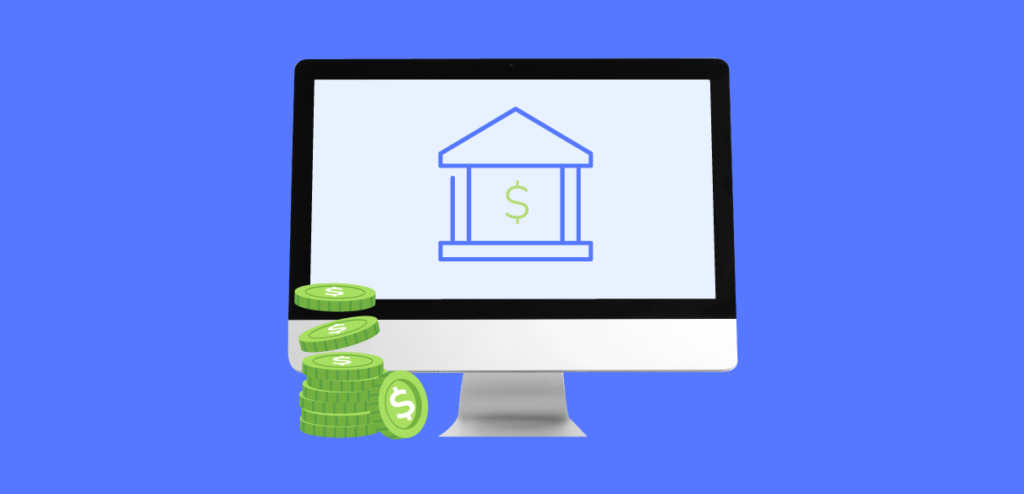In the digital online banking landscape, businesses have increasingly adopted these solutions for convenience, efficiency, and accessibility. However, alongside these benefits come significant risks, particularly in cybersecurity.
This comprehensive guide aims to help businesses navigate the complexities of secure online banking.
Understanding Digital and Online Banking for Businesses
Digital and online banking refer to the financial services that financial institutions offer over the Internet. Businesses can utilize these services to manage their bank accounts, initiate an online bank account, and transfer money, all through digital platforms.
By allowing access to account information and transactions via computers or mobile devices, these services provide an effective solution for businesses to operate efficiently without needing to visit physical branches in person.
The Rise of Digital Banking for Businesses

Over the past decade, digital banking has grown exponentially, particularly among small and medium businesses (SMBs) seeking convenience and flexibility. This trend is driven by the increasing demand for comprehensive digital solutions that can handle large transaction volumes and offer advanced financial management tools.
For example, online banks typically provide SMBs with automated payment scheduling and real-time financial reporting, which is essential for managing cash flow and reducing operational costs. According to recent studies, more than 80% of businesses prefer digital banking over traditional methods.
Benefits of Online Banking for Businesses

1. Convenience and Accessibility
Digital and online banking allows businesses to manage their bank accounts online anytime, anywhere, as long as they have Internet access.
This is particularly useful for companies with remote teams or operations in multiple locations, as it eliminates the need to visit physical branches for routine tasks such as viewing and checking account information or initiating external transfers.
2. Streamlined Financial Management
Online banking platforms offer businesses tools to manage their finances efficiently.
For example, they can set up automated bill payments, track deposit details, pay bills and schedule direct deposits for employees. These services help businesses maintain accurate financial records and improve cash flow management.
3. Cost Efficiency
Traditional banks often impose account fees and require a minimum balance to maintain accounts, which can be burdensome for businesses. In contrast, online banks typically have lower fees and more favorable terms, such as no minimum deposit requirements and waived minimum opening deposit.
4. Enhanced Security Features
Security is a primary concern for businesses using banking online.
Fortunately, most financial institutions implement robust security measures, including multi-factor authentication and data encryption, to protect account information from unauthorized access. Additionally, these institutions offer fraud detection tools and 24/7 monitoring to identify and prevent suspicious activities.
Common Security Challenges in Online Banking
While digital and online banking offers numerous benefits, businesses must be aware of the security challenges that can arise. Understanding and addressing these issues is critical for protecting sensitive financial data and maintaining smooth business operations.

Here are some of the most prevalent challenges:
Cybersecurity Threats
The primary concern for businesses utilizing online banking is cybersecurity.
Cybercriminals frequently target financial institutions to gain unauthorized access to sensitive data or carry out fraudulent transactions. This can result in significant financial losses and damage a company’s reputation.
Businesses must implement stringent security practices to safeguard their information. For example, it is essential to secure every bank account online with strong passwords, enable MFA, and monitor for unusual activity. Bancoli enhances these efforts by providing military-grade encryption, real-time fraud monitoring, and ID live check verification, offering an additional security layer against sophisticated cyber threats.
User Authentication Issues
Ensuring that only authorized personnel can access a business’s online bank accounts can be complex. Weak passwords, phishing attacks, and insufficient user management can lead to unauthorized access when banking online, potentially allowing attackers to transfer funds or send money without permission.
Multi-factor authentication (MFA) is crucial in mitigating these risks. MFA requires users to provide two or more verification methods before accessing an account, making it much harder for unauthorized individuals to gain access. This is especially important for businesses managing multiple bank accounts and sensitive checking account information.
Bancoli’s security protocols include MFA, ensuring only verified users can access the bank account online and perform critical functions like initiating a direct deposit to transfer money or making external transfers.
The Importance of Choosing the Right Financial Institution
When selecting an online banking provider for business, it is essential to consider various factors to ensure that the chosen financial institution’s online side meets the business’s specific security and operational needs. Here are key aspects businesses should evaluate:
Robust Security Features
Security is a critical factor when choosing an online banking provider. Look for online banks that offer multi-factor authentication, biometric logins, and real-time transaction alerts. Bancoli sets a high standard with its comprehensive security features, including fraud monitoring and ID live check verification. These features help businesses protect their financial data and prevent unauthorized access.
FDIC Insurance and Fund Protection
Businesses should ensure that the bank is FDIC-insured (Federal Deposit Insurance Corporation) to protect deposits up to $250,000 in case of a bank failure.
However, it’s essential to consider additional protection for businesses that maintain large balances. Bancoli offers funds protection up to $125 million, giving businesses peace of mind that their assets are secure beyond the standard FDIC limits.
Comprehensive Range of Services
Businesses should choose a bank that offers a full range of services tailored to their needs, such as online bank accounts, advanced security features like transaction alerts and fraud detection, and integrated tools like multi-currency invoicing that add value to businesses.

Additional Considerations for Businesses
- Scalability and Flexibility: As businesses grow, their banking needs may change. Choosing a bank that can scale its services, like Bancoli, ensures that businesses have the flexibility to expand their financial operations without compromising security or service quality.
- Proactive Fraud Detection: Banks that actively monitor accounts for suspicious activity and alert businesses to potential fraud can significantly reduce the risk of financial loss. Bancoli’s proactive approach to fraud detection and monitoring shows how digital and online banks can protect their clients from emerging threats.
Best Practices for Securing Your Business Online Banking
Businesses must implement robust security measures to safeguard sensitive financial data. This guide provides a comprehensive approach to enhancing the security of digital and online banking systems, focusing on both basic and advanced strategies.

Use Complex and Unique Passwords
The first line of defense in securing an online bank account is using strong, unique passwords. A secure password should include a mix of uppercase and lowercase letters, numbers, and special characters. For example, instead of using a common phrase like “Company2023,” opt for something complex like “C0mp@ny!2o2e#SeK_r3.”
Avoid using easily guessable information, such as birthdays or company names, and never reuse passwords across multiple accounts. This is particularly important if you manage several bank accounts or deal with different online or traditional banks, that may each have their security requirements.
Enable Multi-Factor Authentication (MFA)
Multi-factor authentication (MFA) provides an additional layer of security by requiring multiple verification forms before granting access. This could involve something you know (password), something you have (smartphone), and something you are (biometric data).
For example, a financial institution’s online system might send a verification code to your phone after you’ve entered your password or prompt for a fingerprint scan before allowing you to transfer money or view deposit details. This extra step is crucial in preventing unauthorized access to sensitive functions like your deposit details, initiating a direct deposit, or setting up an external transfer.
Regularly Update Software and Systems
Ensuring that all devices used to access online bank accounts are regularly updated is crucial. Software updates often include patches for security vulnerabilities that cybercriminals can exploit.
For instance, if you use a specific financial app to manage your checking account or pay bills, ensure it’s set to update automatically. This reduces the risk of outdated software weakening your security infrastructure, especially compared to brick-and-mortar banks that might rely on older systems for in-person services.
Monitor Account Activity Regularly

Set up alerts for unusual activities, such as large transfers or withdrawals, to detect suspicious behavior early. For instance, if your business typically makes transfers below $5,000, an alert for any transaction above this amount could help detect potential fraud.
Regular monitoring of bank accounts also helps track minimum balance requirements and avoid penalties that online banks may impose if they charge monthly fees. Early detection is crucial, as it can prevent unauthorized access and potential financial losses before they escalate.
Limit Access to Your Online Bank Account
Implement strict user management policies. Only authorize employees who need access to specific checking accounts or other sensitive functions for their roles.
For example, a payroll manager might need access to an online bank account to set up a direct deposit but should not be able to transfer funds to external bank accounts. Regularly review and update permissions, especially if employees change roles or leave the company. This minimizes the risk of unauthorized access and ensures that only those who require access to perform their duties can reduce potential vulnerabilities.
Security Strategies for Small Businesses

Small businesses often have limited resources, making them vulnerable to cyber threats. The following practices are designed to help any small business secure their bank accounts online.
Separate Business and Personal Accounts
Maintaining separate accounts for business and personal use is essential. Imagine paying for business expenses but accidentally using your personal checking account.
This complicates tax reporting and increases the risk of mixing personal and business funds, which could lead to unauthorized withdrawals or even fraud. Keeping separate accounts also helps track business cash flow, ensuring that business transactions are isolated for accurate financial reporting.
Use a Secure Internet Connection
Always access banking online through a secure connection. For instance, public Wi-Fi can expose your sensitive data to hackers if you’re at a coffee shop and need to send money to a supplier. Instead, use a virtual private network (VPN) to encrypt the connection and protect your business information.
This practice is crucial for businesses that rely on online banks and need to ensure their transactions remain secure, especially when accessing their minimum deposit or checking minimum opening deposit requirements.
Implement Transaction Limits and Alerts
Set limits on the amount that can be transferred from your bank accounts to prevent unauthorized large withdrawals. For example, if your business transaction is under $5,000, setting a limit above this amount can be a safeguard.
Enabling alerts for transactions exceeding a certain threshold ensures you’re immediately notified of any suspicious activity, allowing you to respond promptly. This is especially important for small businesses using online banks (FDIC-insured) to receive clients’ money or manage funds. By closely monitoring these transactions, you can better protect your business finances from fraud.
Establishing a Culture of Security
Building a security-conscious culture within the organization is essential for safeguarding sensitive data and maintaining trust with customers and partners.
This involves implementing technical measures and fostering an environment where every employee understands the importance of security and their role in protecting the company’s assets.
Develop a Comprehensive Security Policy
A clear and comprehensive security policy should be the foundation of your organization’s security culture. This policy should clearly outline the roles and responsibilities of all employees, acceptable technology use, and procedures for reporting security incidents.
For example, if your business uses online banks to manage financial operations, the policy should specify that only authorized personnel can access the checking account information and that strong passwords and multi-factor authentication must be used.
It’s also crucial to regularly update this policy to adapt to new threats. Imagine that a new type of phishing attack is targeting online banks. If your policy isn’t updated to address this threat, employees might fall victim, potentially allowing attackers to gain unauthorized access and receive money fraudulently.
Promote Awareness and Training Programs
Security awareness programs are vital for educating employees on the latest threats and best practices for protecting accounts and sensitive information. For example, you could conduct workshops that cover topics such as creating strong passwords, recognizing phishing emails, and using secure internet connections.
Imagine an employee receiving a suspicious email asking for the company’s checking account details. Without proper training, they might unknowingly provide this information, risking your business. Awareness programs equip employees to identify such threats and act appropriately.
Training should also include the specific procedures for reporting security incidents. If an employee notices a suspicious attempt to receive money from the company’s checking account, they should know precisely who to inform and what steps to take. This proactive approach can prevent potential security breaches before they escalate.
Encourage a Proactive Approach to Security
Encouraging employees to report suspicious activities or potential vulnerabilities is a key component of a security-conscious culture. Establish a clear process for reporting these concerns and ensure employees feel comfortable using it.
Consider implementing a rewards system for employees who identify potential security risks or suggest improvements. For example, if an employee suggests a more secure way to handle the minimum deposit processes required by such banks, recognizing their contribution reinforces the importance of vigilance and continuous improvement in security practices.
Foster Collaboration Between Departments

Security is a shared responsibility that involves all departments, not just the IT team. Collaboration between IT, finance, and human resources is crucial for addressing security risks comprehensively. For example, the finance team should work with IT to ensure that the systems managing online banks are secure and that access to sensitive financial information is restricted.
Consider a situation where the HR department is onboarding new employees. Collaboration with the IT team ensures that the new hires have secure access to the systems they need, while the finance team can ensure that these employees only have the necessary permissions for their role. This coordinated effort significantly strengthens the business’s overall security posture.
Moreover, regular cross-departmental meetings can help identify potential vulnerabilities and develop joint strategies for managing them. Collaborative efforts ensure a more holistic approach to security across the organization.
Advanced Security Strategies for Digital & Online Banking

Advanced strategies, such as enhanced authentication methods and network security protocols, are crucial for businesses seeking higher security.
Biometric Verification
Biometric authentication, like fingerprint scanning or facial recognition, adds an extra layer of security. It is difficult to replicate, making it ideal for protecting online bank accounts.
Behavioral Biometrics
Behavioral biometrics analyze patterns like typing speed and device usage to identify anomalies. This method can detect if an unauthorized user gains online access to a bank account.
Hardware-Based Security Tokens
Hardware tokens generate a one-time code that must be used along with a password. This method requires token possession and provides robust security against unauthorized access.
Implementing Robust Network Security Protocols
When managing digital financial services, businesses must implement robust network security protocols to protect sensitive data and maintain the integrity of their financial operations. This is especially important for businesses using online banks, as their services are accessed exclusively through the Internet, making them a prime target for cyber threats.
Secure Socket Layer (SSL) Encryption
SSL encryption ensures that all data transmitted between the user’s browser and the bank’s servers is secure. Only access online banks and digital financial services with SSL-protected websites to safeguard sensitive information.

Virtual Private Networks (VPNs)
A VPN adds a layer of security by encrypting the internet connection and masking the IP address. It’s essential for accessing bank accounts from remote or public locations.
Firewalls and Intrusion Detection Systems (IDS)
Firewalls block unauthorized access to the network, while IDS monitor for suspicious activity. Combined, they offer robust protection for banking online systems against cyberattacks.

Key Takeaways to Secure Your Online Banking Operations
Securing online banking is a critical responsibility for businesses. By implementing the best practices outlined in this guide, businesses can significantly reduce the risk of financial fraud and data breaches. Here are the key takeaways:
- Prioritize Strong Authentication Methods: Use multi-factor authentication and consider implementing biometric verification to secure bank accounts online.
- Monitor and Limit Access: Regularly review access permissions to ensure only authorized personnel can access sensitive bank accounts.
- Use Advanced Security Technologies: Leverage AI, machine learning, and encryption technologies to enhance the security of online banking systems.
- Stay Informed About Emerging Threats: Keep up-to-date with the latest cybersecurity trends and threats, and adapt your security measures accordingly.
- Collaborate with Financial Institutions: Work closely with your financial institution to understand their security measures and utilize their available tools and resources.

In Conclusion
Securing business banking operations in the digital era requires a comprehensive approach to mitigate significant cybersecurity risks. Implementing strong authentication methods, regularly monitoring your checking account activities, and choosing the right financial institution is crucial for protecting sensitive financial data.
Businesses should be especially cautious with online banks that offer digital-only services, ensuring they provide robust security features like multi-factor authentication and data encryption.
For businesses with global operations, partnering with a secure financial institution like Bancoli can make a significant difference. Bancoli’s Global Business Account offers military-grade encryption, real-time fraud monitoring, and ID live check verification, providing an added layer of protection.
With funds protection up to $125 million, Bancoli ensures businesses can conduct online banking confidently, safeguarding their financial assets against sophisticated cyber threats.





